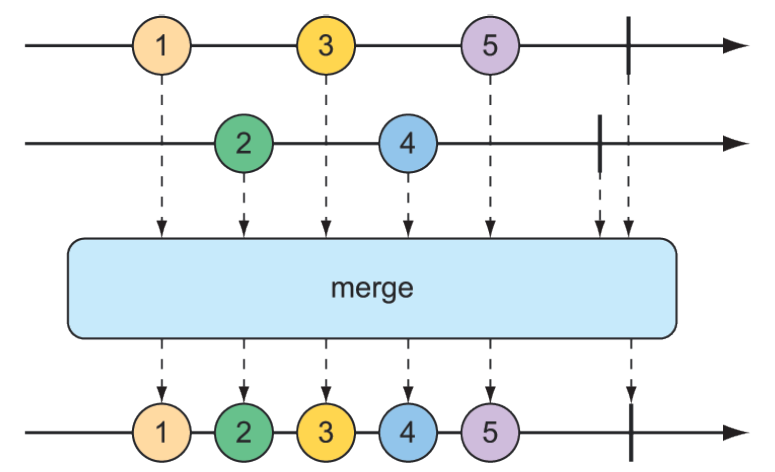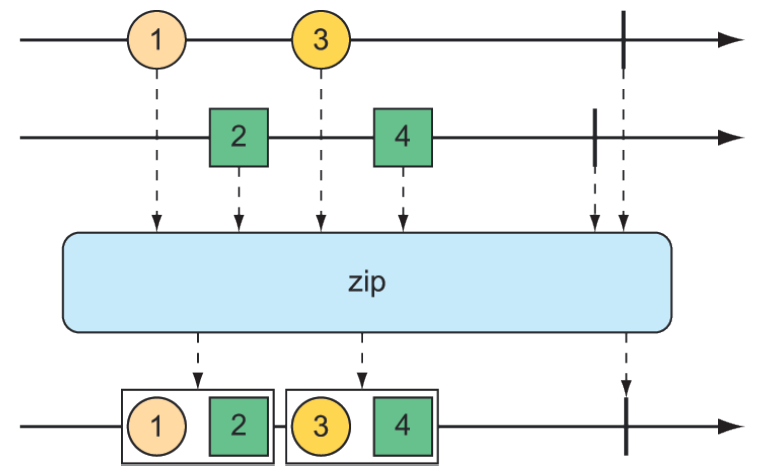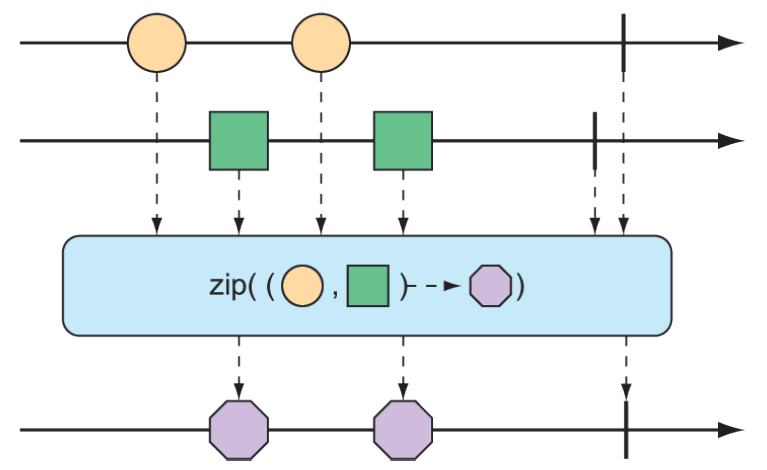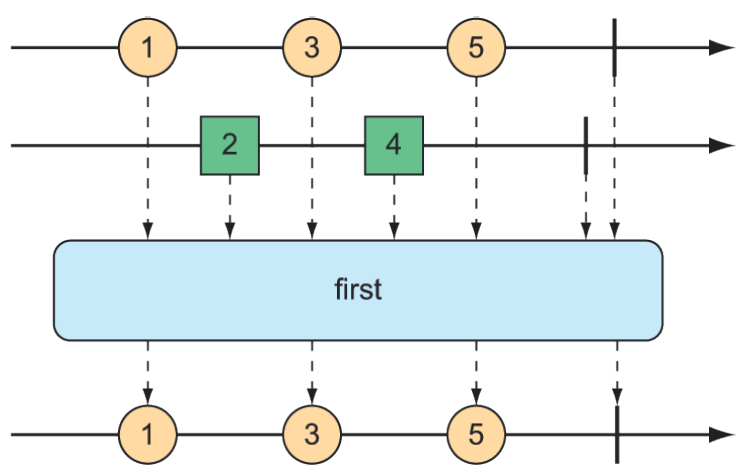11.3.2 Combining reactive types
You may find yourself with two reactive types that you need to somehow merge together. Or, in other cases, you may need to split a Flux into more than one reactive type. In this section, we’ll examine operations that combine and split Reactor’s Flux and Mono.
MERGING REACTIVE TYPES
Suppose you have two Flux streams and need to create a single resulting Flux that will produce data as it becomes available from either of the upstream Flux streams. To merge one Flux with another, you can use the mergeWith() operation, as illustrated with the marble diagram in figure 11.6.
 Figure 11.6 Merging two
Figure 11.6 Merging two Flux streams interleaves their messages into a new Flux.
For example, suppose you have a Flux whose values are the names of TV and movie characters, and you have a second Flux whose values are the names of foods that those characters enjoy eating. The following test method shows how you could merge the two Flux objects with the mergeWith() method:
@Test
public void mergeFluxes() {
Flux<String> characterFlux = Flux
.just("Garfield", "Kojak", "Barbossa")
.delayElements(Duration.ofMillis(500));
Flux<String> foodFlux = Flux
.just("Lasagna", "Lollipops", "Apples")
.delaySubscription(Duration.ofMillis(250))
.delayElements(Duration.ofMillis(500));
Flux<String> mergedFlux = characterFlux.mergeWith(foodFlux);
StepVerifier.create(mergedFlux)
.expectNext("Garfield")
.expectNext("Lasagna")
.expectNext("Kojak")
.expectNext("Lollipops")
.expectNext("Barbossa")
.expectNext("Apples")
.verifyComplete();
}Normally, a Flux will publish data as quickly as it possibly can. Therefore, you use a delayElements() operation on both of the created Flux streams to slow them down a little—emitting an entry only every 500 ms. Furthermore, so that the food Flux starts streaming after the character Flux, you apply a delaySubscription() operation to the food Flux so that it won’t emit any data until 250 ms have passed following a subscription.
After merging the two Flux objects, a new merged Flux is created. When StepVerifier subscribes to the merged Flux, it will, in turn, subscribe to the two source Flux streams, starting the flow of data.
The order of items emitted from the merged Flux aligns with the timing of how they’re emitted from the sources. Because both Flux objects are set to emit at regular rates, the values will be interleaved through the merged Flux, resulting in a character, followed by a food, followed by a character, and so forth. If the timing of either Flux were to change, it’s possible that you might see two character items or two food items published one after the other.
Because mergeWith() can’t guarantee a perfect back and forth between its sources, you may want to consider the zip() operation instead. When two Flux objects are zipped together, it results in a new Flux that produces a tuple of items, where the tuple contains one item from each source Flux. Figure 11.7 illustrates how two Flux objects can be zipped together.
 Figure 11.7 Zipping two
Figure 11.7 Zipping two Flux streams results in a Flux containing tuples of one element from each Flux.
To see the zip() operation in action, consider the following test method, which zips the character Flux and the food Flux together:
@Test
public void zipFluxes() {
Flux<String> characterFlux = Flux
.just("Garfield", "Kojak", "Barbossa");
Flux<String> foodFlux = Flux
.just("Lasagna", "Lollipops", "Apples");
Flux<Tuple2<String, String>> zippedFlux =
Flux.zip(characterFlux, foodFlux);
StepVerifier.create(zippedFlux)
.expectNextMatches(p ->
p.getT1().equals("Garfield") &&
p.getT2().equals("Lasagna"))
.expectNextMatches(p ->
p.getT1().equals("Kojak") &&
p.getT2().equals("Lollipops"))
.expectNextMatches(p ->
p.getT1().equals("Barbossa") &&
p.getT2().equals("Apples"))
.verifyComplete();
}Notice that unlike mergeWith(), the zip() operation is a static creation operation. The created Flux has a perfect alignment between characters and their favorite foods. Each item emitted from the zipped Flux is a Tuple2 (a container object that carries two other objects) containing items from each source Flux, in the order that they’re published.
If you’d rather not work with a Tuple2 and would rather work with some other type, you can provide a Function to zip() that produces any object you’d like, given the two items (as shown in the marble diagram in figure 11.8).
 Figure 11.8 An alternative form of the
Figure 11.8 An alternative form of the zip() operation results in a Flux of messages created from one element of each incoming Flux.
For example, the following test method shows how to zip the character Flux with the food Flux so that it results in a Flux of String objects:
@Test
public void zipFluxesToObject() {
Flux<String> characterFlux = Flux
.just("Garfield", "Kojak", "Barbossa");
Flux<String> foodFlux = Flux
.just("Lasagna", "Lollipops", "Apples");
Flux<String> zippedFlux =
Flux.zip(characterFlux, foodFlux, (c, f) -> c + " eats " + f);
StepVerifier.create(zippedFlux)
.expectNext("Garfield eats Lasagna")
.expectNext("Kojak eats Lollipops")
.expectNext("Barbossa eats Apples")
.verifyComplete();
}The Function given to zip() (given here as a lambda) simply concatenates the two items into a sentence to be emitted by the zipped Flux.
SELECTING THE FIRST REACTIVE TYPE TO PUBLISH
Suppose you have two Flux objects, and rather than merge them together, you merely want to create a new Flux that emits the values from the first Flux that produces a value. As shown in figure 11.9, the firstWithSignal() operation picks the first of two Flux objects and echoes the values it publishes.
 Figure 11.9 The first() operation chooses the first Flux to emit a message and thereafter produces messages only from that Flux.
Figure 11.9 The first() operation chooses the first Flux to emit a message and thereafter produces messages only from that Flux.
The following test method creates a fast Flux and a slow Flux (where “slow” means that it will not publish an item until 100 ms after subscription). Using firstWithSignal() it creates a new Flux that will publish values only from the first source Flux to publish a value.
@Test
public void firstWithSignalFlux() {
Flux<String> slowFlux = Flux.just("tortoise", "snail", "sloth")
.delaySubscription(Duration.ofMillis(100));
Flux<String> fastFlux = Flux.just("hare", "cheetah", "squirrel");
Flux<String> firstFlux = Flux.firstWithSignal(slowFlux, fastFlux);
StepVerifier.create(firstFlux)
.expectNext("hare")
.expectNext("cheetah")
.expectNext("squirrel")
.verifyComplete();
}In this case, because the slow Flux won’t publish any values until 100 ms after the fast Flux has started publishing, the newly created Flux will simply ignore the slow Flux and publish values only from the fast Flux.
